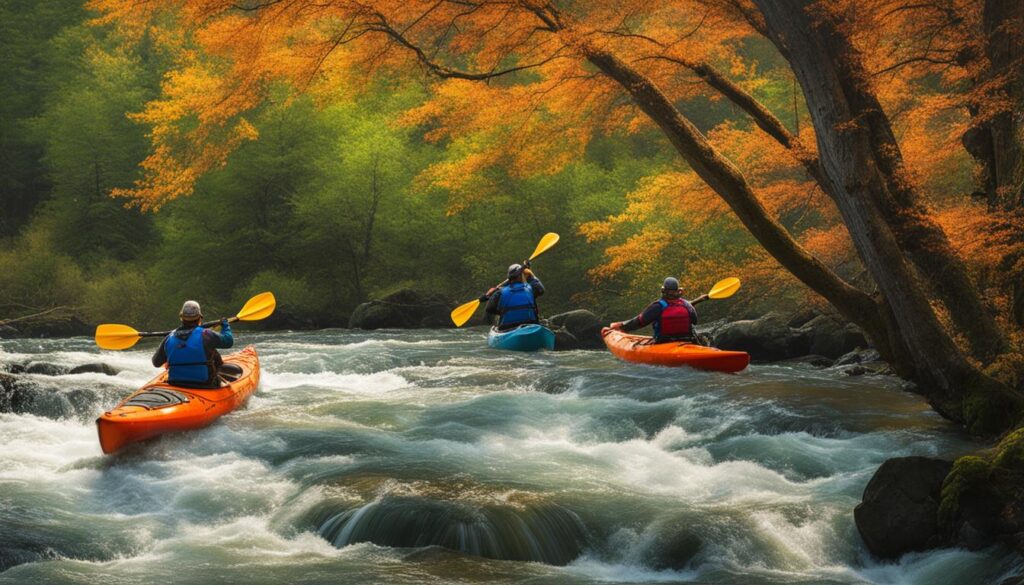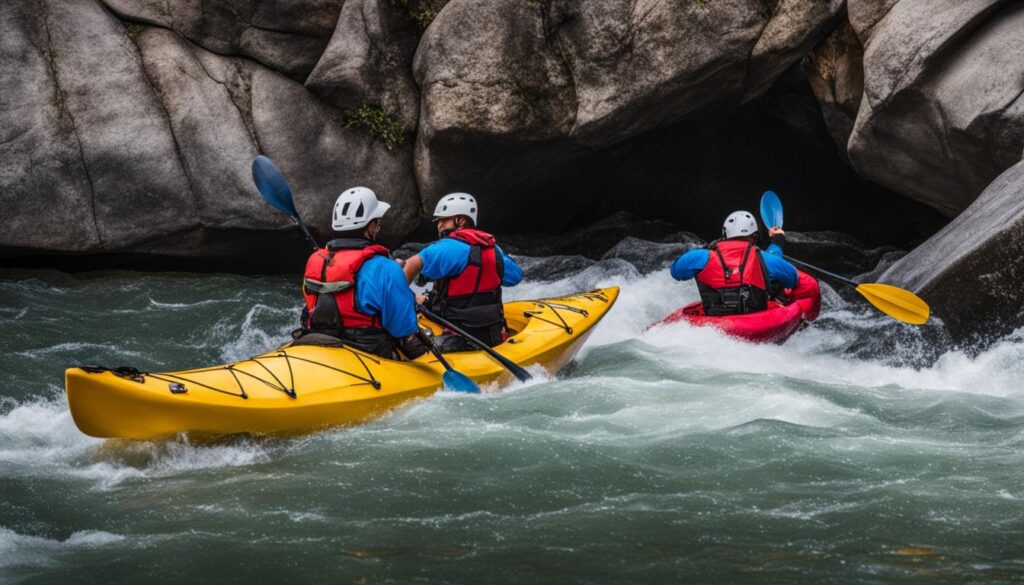Whitewater kayaking is an exhilarating adventure that brings you closer to nature and tests your skills on the river. However, it’s important to be aware of the potential hazards that can arise during your kayaking journey. By identifying these hazards and taking appropriate measures, you can ensure a safe and enjoyable experience.
In this article, we will delve into the six most common hazards in whitewater kayaking, including strainers, sieves, foot entrapment, holes, undercuts, and the varying flow of the water. Understanding these hazards and how to avoid them is essential for your safety.
Key Takeaways:
- Identify hazards in whitewater kayaking to minimize risks and stay safe on the river.
- Avoid strainers and portage around them to prevent entrapment.
- Recognize the dangers of sieves and approach them with caution.
- Understand foot entrapment and practice defensive swimming techniques.
- Be aware of the changing flow of the river and adjust your approach accordingly.
Strainers and Portaging Around Them
When kayaking in whitewater, it’s important to be aware of the potential hazards that can arise on the river. One common hazard that kayakers should be cautious of is strainers. Strainers are obstructions in the river that allow water to pass through but retain larger objects like trees or debris. They can be extremely dangerous and have the potential to trap kayakers and cause them to become stuck underwater.
To avoid strainers, it’s crucial to actively paddle or swim away from them when they are spotted. If it’s not possible to avoid a strainer while swimming, it’s important to swim hard to get on top of it and protect your airway. This will help ensure your safety and reduce the risk of becoming trapped.
Another strategy for avoiding strainers is portaging. Portaging involves carrying your kayak around obstructions in the river. This can be done by carefully maneuvering out of the water and carrying your kayak to a safe area below the strainer. It’s important to assess the situation and determine the best course of action based on the specific circumstances and the skill level of the kayaker.
| Strainer Identification | Avoidance Techniques | Portaging |
|---|---|---|
| Look for objects like trees or debris blocking the path of the river. | Actively paddle or swim away from strainers. | Maneuver out of the water safely and carry your kayak around the strainer. |
| Be cautious after heavy rains or flooding, as new objects may be brought downstream. | Swim hard to get on top of the strainer and protect your airway. | Assess the situation and determine the best course of action based on the circumstances and skill level. |

By being aware of strainers and implementing strategies like actively avoiding them or portaging around them, kayakers can minimize their risk and ensure a safe and enjoyable experience on the river.
Sieves and their Dangers
Sieves are a significant hazard in whitewater kayaking, and understanding their dangers is crucial for ensuring a safe experience on the river. Unlike strainers, which are caused by vegetation and debris, sieves are formed by rocks or the riverbed itself. They are typically found in boulder-choked areas, where water can pass through but human or boat entrapment is possible. Recognizing sieves can be challenging, as the water simply disappears into the rocks instead of being displaced.
To avoid the dangers of sieves, kayakers must exercise caution and take appropriate measures. It is advisable to approach rapids or areas with significant elevation changes with extra care, as sieves are often found in these locations. Ideally, kayakers should try to circumvent sieves altogether. If encountering a potential sieve, it is important to assess the situation and make a decision based on the level of risk involved. Safety should always be prioritized, and if there is a doubt about the presence of a sieve, it is recommended to avoid the area entirely.
Remember, the key to avoiding sieves in whitewater kayaking is awareness and judgment. Regularly honing your ability to recognize sieves and understanding their inherent dangers will greatly contribute to your safety on the river. By staying informed, you can confidently navigate rapids and sections with potential sieves, minimizing risks and enjoying the thrill of whitewater kayaking to the fullest.
Foot Entrapment and Safety Measures
When it comes to whitewater kayaking, understanding foot entrapment and taking appropriate safety measures is crucial. Foot entrapment occurs when the irregular riverbed combined with the force of the current causes a kayaker’s feet to become caught and trapped underwater. This situation can quickly turn dangerous, as rescue time is limited and the risk of drowning is high. To avoid foot entrapment accidents, it’s essential to be aware of the river’s uneven bottom and take defensive swimming precautions.
While on the river, never attempt to stand up in fast-moving water as it significantly increases the chances of foot entrapment. Instead, if you find yourself swimming in shallow water, assume a defensive swimming position. This means keeping your nose and toes out of the water while facing downstream. By positioning yourself in this way, you can reduce the risk of your feet becoming caught and increase your chances of a successful rescue.
It’s important to note that defensive swimming should only be used in shallow water and when foot entrapment is a possibility. In deeper sections of the river, it’s best to rely on your kayak for flotation and use it to navigate to a safer location. Additionally, always keep a keen eye on the river’s conditions, looking for signs of potential foot entrapment hazards such as areas with fast-moving water over an uneven riverbed or submerged obstacles.
Foot Entrapment Safety Tips:
- Never attempt to stand up in fast-moving water.
- When swimming in shallow water, assume a defensive swimming position with your nose and toes out of the water, facing downstream.
- Use your kayak for flotation and navigation in deeper sections of the river.
- Be vigilant for signs of potential foot entrapment hazards, such as fast-moving water over an uneven riverbed or submerged obstacles.

| Hazard | Description | Safety Measures |
|---|---|---|
| Foot Entrapment | The riverbed combined with current causes a kayaker’s feet to get caught and be pushed face down by the weight of the river. | – Never stand up in the river – Assume a defensive swimming position in shallow water – Keep a keen eye on river conditions |
| Strainers | Obstructions that allow water to pass through, but trap larger objects like trees or debris. | – Paddle or swim away from strainers – Swim hard to get on top of a strainer if unavoidable |
| Sieves | Rock or riverbed formations that allow water to disappear into groups of rocks, trapping humans or boats. | – Be cautious and avoid sieves – Approach with caution or avoid entirely |
| Flow Variations | Changes in water levels can introduce new hazards or make the river more dangerous. | – Understand the dynamics of river flow – Be prepared for additional challenges |
By understanding foot entrapment and taking appropriate safety measures, you can reduce the risk of accidents and ensure a safer kayaking experience. Remember to always prioritize your safety on the river and stay vigilant for potential hazards. Happy paddling!
Understanding Flow and Other Hazards
Kayaking in whitewater can be an exhilarating and thrilling adventure, but it’s essential to understand and respect the power of the river. One key factor to consider is the flow of the water, which can significantly impact the difficulty and hazards you may encounter. By understanding river flow, you can better prepare yourself for the challenges that lie ahead.
River flow is influenced by various factors, including water levels and weather conditions. When water levels rise, the river becomes more challenging and can introduce additional hazards like strainers, sieves, and holes. These obstacles can be dangerous and require careful navigation. On the other hand, when water levels drop, new hazards may emerge, such as unseen undercut rocks. Being aware of these changes in river flow is crucial for your safety.
In addition to understanding river flow, it’s important to be aware of other common hazards you may encounter during your whitewater kayaking experience. Wildlife encounters can occur, so it’s vital to know how to react appropriately and avoid any potential conflicts. Emergency scenarios can also arise, such as equipment failure or injuries, so it’s wise to have a plan and be prepared to handle unexpected situations.
While challenging water conditions can be thrilling, it’s vital to prioritize safety. Always wear appropriate safety gear, such as a helmet and a personal flotation device. Be mindful of your skill level and choose rivers and sections that match your abilities. If you’re not confident in your skills or capabilities, consider taking a kayaking course or going with an experienced guide. Remember, your safety should always be the top priority when engaging in whitewater kayaking.
FAQ
How can I identify hazards in whitewater kayaking?
Some common hazards in whitewater kayaking include strainers, sieves, foot entrapment, holes, undercuts, and the varying flow of the water. By recognizing and understanding these hazards, you can minimize your risk and stay safe during your adventures.
What are strainers and how can I avoid them?
Strainers are obstructions in the river that allow water to pass through but retain larger objects, such as trees or man-made debris. They can be extremely dangerous as they can trap kayakers and cause them to become stuck underwater. To avoid a strainer, actively paddle or swim away from it when spotted. If the strainer is unavoidable while swimming, swim hard to get on top of it and protect your airway.
What are sieves and how can I avoid them?
Sieves are similar to strainers but caused by rock or the riverbed rather than vegetation or debris. They are normally boulder-choked areas that allow water to pass through but can trap humans or boats. Sieves can be difficult to recognize as the water simply disappears into groups of rocks instead of being displaced. Always be cautious and try to avoid sieves, especially in rapids or areas with significant elevation changes.
What is foot entrapment and how can I stay safe?
Foot entrapment occurs when uneven riverbed combined with current causes a kayaker’s feet to get caught and be pushed face down by the weight of the river. This situation is extremely dangerous, as rescue time is limited. To stay safe, never stand up in the river to avoid foot entrapment and swim in shallow water in a defensive swimming position with your nose and toes out of the water, facing downstream.
How does the flow of the river affect kayaking and what should I be aware of?
The flow of the river plays a significant role in determining the difficulty and hazards present. As water levels rise, more obstacles such as strainers, sieves, and holes can come into play, making the river more dangerous. Conversely, when the water levels drop, new and unexpected hazards such as unknown undercut rocks can emerge. It is crucial to understand the changing dynamics of the river flow and be prepared for the additional challenges that may arise.





